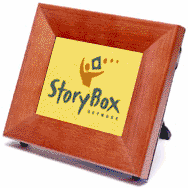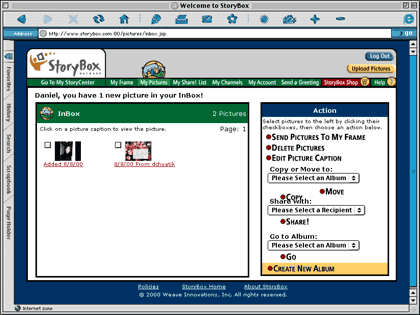Preview: Kodak Smart Picture Frame

Developer: Weave Innovations
Price: $349 (includes six months of premium service)
Requirements: Mac with Internet connection, Netscape 4 or later or Internet Explorer 5 or later.
Computer technology keeps creeping into our lives. Computers used to be simply tools for work, and many people were happy to enter a computer-free environment after the work was done. Staring at a flickering screen for several hours a day is quite enough for them. But as speed, bandwidth, and memory capacity keep increasing, computers and the associated technologies are no longer restricted to the workplace. The emergence of MP3s is one example. Although the MP3 standard started more or less as a pure computer-side compression scheme, MP3 players are now a common item outside of the office. Similarly, Apple’s iMovie takes an activity that was previously separated from the digital world entirely, and literally brings it to your desktop.
Pictures were similarly “digitized.” And while digital cameras used to be a geek toy or restricted to professional use, they are quickly becoming an everyday item. For some people, they have entirely displaced traditional film cameras. But such computerization has its growing pains. Like MP3s, which in the beginning were not good for much else but listening on mediocre computer speakers, digital pictures were mostly restricted to the digital canvas on your computer screen. Yet, as often happens when such “advances” hit mainstream computing, people miss some features of the “traditional” technology—in this case of the simple feel of a photograph. A digital picture is nice, but it just doesn’t have the texture of a freshly developed piece of photographic paper, nor its gloss. You can’t put a digital picture into a “real” photo album or give it centerpiece status in a picture frame. And you can’t really show it to your computer-less grandparents unless you carry your laptop with you to the next family reunion.
Improvements in printer technology, which now give us a wide choice of photo-quality printers, have removed some of those drawbacks, but at the cost of the convenience and speed that are at the core of digital pictures. What good are digital pictures if you have to print all of them out again, converting them back to the analog format that we tried to avoid in the first place?
• • •
Weave Innovations’ Kodak Smart Picture Frame and StoryBox Network picture exchange service attack just this issue. By combining the more traditional feel of a (digital) picture frame with the vast modern information handling capacities of the Internet, their product promises to combine the best of both worlds on its 6.4 inch color LCD. Weave Innovations was kind enough to provide ATPM with some pre-production units for preview purposes. The units gave us a glimpse at the future of digital imaging. However, some technical glitches in the beta units prevented us from taking them through a full review. Instead, we will share our thoughts with you now, and hopefully follow up with a full review of the customer units in our next issue.
 |
You may already have seen digital photo frames in stores by now. Sony’s play on the theme is modern and high-tech looking. Weave Innovations decided on a more traditional, wooden look. While Sony’s picture frame accepts only their proprietary memory stick, the Kodak Smart Picture Frame—which will be distributed by Kodak later this year—accepts both CompactFlash cards and an “online” connection through your familiar phone line. The phone line serves as the primary means of connecting the outside world to your picture frame. When you setup the frame, you have to register at the StoryBox Network Web site. The frame dials a free 800 number, confirms it is properly registered, and then finds the best local phone number for future connections. Through the Web site, you can upload your own pictures to the frame; send and receive greeting cards; share pictures with others; and even set news, weather, sports and similar “channel” content to be loaded into your frame.
 |
The Web site lets you set up a contact database and allow others (like your kids, your parents, or your significant other on the road) to send their pictures directly to your frame. Imagine the glow on mom’s face if her kid in college sends a weekly picture to her frame. Certainly, you could simply e-mail the images, but it’s less personal and not everyone has e-mail access. In this way, a frame may be a wonderful gift for a technologically challenged family member (just make sure you set it up for him), but even hard-core technophiles may enjoy this little gadget. I, personally, spend a lot of time—professionally and personally—on the Net, but I would appreciate it if I could shift some of that use away from the computer, because I can’t even recall the last time I sat down in my living room. The addition of informational content channels allows you to take a break from the screen and get your dose of information overload in a different way.
The frame itself can rotate images, and you can share pictures among several frames. Instead of showing a single static picture, you can have all of the images displayed in a slide show fashion. Who knows, maybe future versions will even support simple movie-playback, allowing your friends and relatives to send over a little iMovie of the last vacation!
Not everything is rosy though. Support for the less technical among us may leave power users without the tweaks they want. I wish the frame could bypass my slow phone line and get its content through my DSL connection via the Ethernet LAN. Of course, I am part of a small, but growing minority with faster network connections. Alternatively, a direct USB connection to the frame to upload pictures would be nice. In any case, you can forget about watching movies in future frames if the bandwidth issue isn’t addressed. Also, to use the frame efficiently with Web sharing and channels, you are required to buy a subscription, starting at $4.95, and ramping steeply upwards depending on how many channels and updates per month you want to purchase. At least those with cravings for real paper can have the photos printed and sent home by Kodak.
• • •
Like MP3 players, digital picture distribution via more traditional means will become more common in the next years. Besides simply presenting the images, they will make sharing of images and information easier than ever. I can’t wait to see more of the future.
Reader Comments (12)
If you bought a frame and would like to use it without the network connection (i.e. just from the compact flash card), Kodak can send you a firmware upgrade to do this. Contact me for more details.
Andrew
thanks again,
Mary Lou
You can check Apple's hardware page for the latest equipment. Essentially now, their computer lineup is as follows:
iMac (consumer desktop)
MacBook (consumer laptop)
Mac Pro (high end desktop)
MacBook Pro (high end laptop)
Mac mini (omnibus use, often good for integrating with a home media system or for those looking for an inexpensive Mac)
Add A Comment